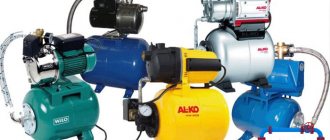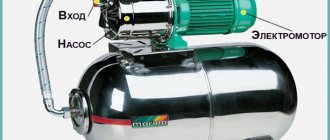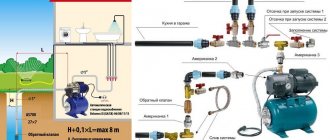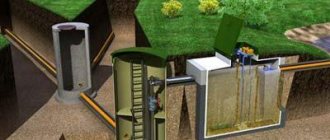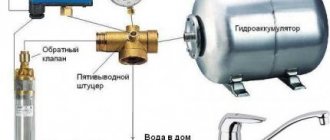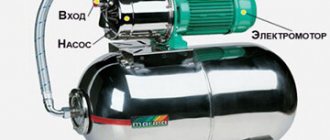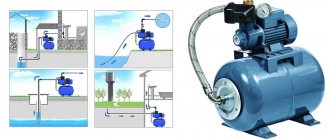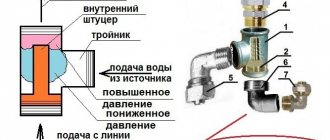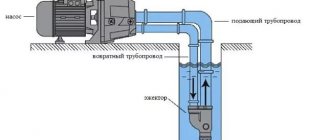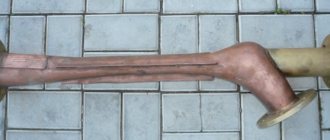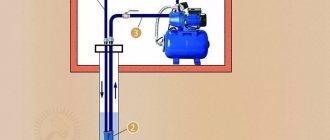General information about filters
The mesh filter belongs to the group of coarse filters, which is a mesh made of stainless metal (steel) or plastic, allowing removal of heavy particles up to 1 mm in size.
A cartridge filter is another type of water pre-purification filter, which has the form of a transparent plastic capsule, inside of which a polypropylene or polyester replaceable cartridge is placed.
By design, the following types of water purification filters are distinguished:
Inlet filter with check valve. This is the same mesh filter, but its distinctive feature is that the hydraulic check valve prevents the return flow of water from the vertical section of the water intake system.
The central filter is often used to purify water intended for irrigation and is located in an open area. Such a filter is installed between sections of hoses.
A suction filter is a mesh in a housing on a hose and is used for collecting water from open reservoirs using motor pumps, tank trucks and hand pumps. The built-in check valve in this filter allows the system to remain filled when the pump is turned off, which facilitates instant start-up.
Installation of mechanical filters is carried out either directly on the pump system itself or next to it.
Advice! It is recommended to install a pre-filter in front of the equipment. This makes it possible to timely clean the filter without damaging the pumping station. Thus, the pressure switch to which the filter is connected transmits a signal to the pump to turn off.
In addition to coarse impurities, water may contain heavy metals, salt ions, microorganisms, bacteria, which makes it unsuitable for human consumption and, as a result, it is necessary to carry out a deeper purification.
How to install a filter for a water station
In Moscow and other large populated areas, you can contact specialists to install a main filter in front of the pumping station. If you have experience and the ability to work with such mechanisms, you can, however, cope with the work yourself.
It is important to first read the instructions that came with the filter device and make sure that you have all the components necessary for the tools to operate.
It is possible to install the device both before and after the pumping unit. It is better to choose a horizontal section of the highway for installation work. The cleaning device is secured using the threaded method.
To increase the strength of joining elements, you should use clamps; in some cases, additional adapters may be required. The filter must be placed so that access to it is not difficult, since consumables will need to be periodically replaced or cleaned.
Installation features depend on whether a surface pump is used or a submersible one.
The order of arrangement of water filters before and after the station
Filtering devices must be placed correctly to achieve the desired effect and protect expensive equipment from damage.
The order of installing cartridges can be found here.
First, systems for coarse cleaning are installed and only after that – fine cleaning. This way, large particles, debris and dirt will first be removed from the liquid, and then dissolved salts, bacteria and protozoa. Filters for coarse cleaning are placed before the pump, fine filters - after it.
Fine filters also come in several varieties:
The most common type, which uses a polymer as a filter material, which is a barrier to all impurities in the water flow.
Membrane filter - in which the water is divided into two parts, the first purified water goes further to the consumer, and the second part, as waste water containing all the impurities, is sent to the sewer.
A wire filter, which is a pipe with stainless metal wire wound around it. Water passing under pressure through the wire is directed into the water supply, and all the pollutants it contains remain inside the cylinder.
Thanks to such a filter, a high degree of purification of the collected water is ensured.
There are the following types of filters based on the method of water purification:
- — Mechanical filters, which are a mesh or cartridge that cleans solid impurities. Such filters are classified as coarse filters.
- — Ion exchange : purify water from salts of heavy metals and other chemical elements.
— Biological : The essence of cleaning this filter is the use of a community of microorganisms capable of purifying water as a result of processing organic substances as food.- - Electric . Ozone in the filter element, under the action of electric current, purifies water from hydrogen sulfide, chlorides, iron and manganese ions.
- - Sorption . Watercourse purification is carried out as a result of the process of absorption of pollutants by an absorber (activated carbon).
When is it necessary to change the cleaner?
Each type of filter has its own cleaning resource.
When it is exhausted, you have to change the filling of the device or install a new, more advanced model. The reasons for replacing the purifier may be different. The presence of even one of them is a reason to buy a fresh cartridge or a new device.
Replacement must be made if:
- technically fell into disrepair;
- cannot cope with the volume of water consumed;
- does not give the desired concentrations of substances in water;
- has exhausted its potential as a purifier.
External signs
You can determine that a working filter needs updating based on several signs. They are common to flow-through, main-line, storage (jug-type) filters and attachments.
A signal for replacement can be:
Change in the taste of water for the worse.- Scale formation when boiling filtered water.
- Reducing the water pressure from the tap (exception: jugs).
- The appearance of sediment when settling the filtered liquid.
- Presence of contamination when inspecting the cartridge in the transparent case.
Tracking these signs is sometimes problematic. The used filter continues to pass water for some time, but without proper cleaning.
Reference! To exclude this option, many manufacturers install special light indicators on devices. The sensor lights up when the purifier resource is exhausted.
According to the regulations
The frequency of replacing the filter element depends primarily on the type of purifier .
- Jugs with a working life of 150-400 liters can be used by a family of three for a month without replacement. After this time, the cartridge must be replaced. Accordingly, in a house where more people live, the filter will need to be updated more frequently.
- Flow systems installed under the kitchen sink operate without replacement for at least three months. In regions with hard water, cartridges need to be changed every 4-6 months. If soft water enters the home and does not create a large load on the filter, then the replacement period is extended to 8-12 months.
- Reverse osmosis filters are also designed to last a long time. At average water consumption, the filter elements in the device are changed once every six months. At the same time, the blocks in the system have different service life. The mineralizing block can be changed every 6-10 months. The carbon post-filter is updated at least once every six months, since with longer use, pathogenic microflora settles on it. The membrane module remains in operation for up to two years.
The service life of faucet nozzles depends on the model and ranges from 300 to 3000 liters. It is recommended to determine the need for replacement based on diagnostic criteria (primarily the quality and pressure of water).- Main mechanical filters installed on cold and hot pipelines need to be replaced on average once every 6-8 months. But most often this time indicator is individual in nature.
Attention! In some cases, due to poor water quality, the filter filling becomes unusable earlier. With small volumes of consumption and a relatively low degree of fluid contamination, the main filter operates for up to 12-18 months.
Installation of a cleaning system
It looks like this:
- First, there are hoses lowered into the well or borehole, then a coarse pre-filter is installed in front of the pump.
- It is recommended to connect the intake filter in a horizontal place in the pipeline, where there is access for the purpose of performing preventive maintenance on the filter, inspecting it and carrying out timely cleaning of the filter material.
- Then comes the pumping unit itself, after which a fine filter is connected directly in front of the tap.
Top 3 best filter manufacturers + useful video
| Filter brand | Photo | Specifications and Features |
| Marina Speroni | The products are suitable for installation in front of watering equipment and for simultaneous operation with water supply machines. The filter cartridges will have to be replaced periodically. It is better to use replacement parts from the same manufacturer. | |
| Basic | Suitable for both household and garden pumps. Thanks to the check valve, the efficiency of pumping equipment increases and its start-up becomes easier. The advantage of this option is its low cost. A hose adapter and clamp are included in the kit. | |
| Elitech | Their coarse cleaners work best with pumps from the same manufacturer. Water gets rid of impurities of different sizes. It has high productivity: the filter unit can pass through up to 3500 liters of water in an hour. The advantage is that the cost is not too high. |
How to clear sand from water
To minimize the level of pollution, it is necessary to take a certain set of measures. What does it include:
- Monitoring the condition of the casing during drilling operations.
- High-quality cleaning of new equipment.
- Avoiding long pauses in construction.
By following these tips, you can greatly reduce the risk of sand particles getting into the water, but you won’t be able to completely avoid it. In any case, effective cleaning will require high-quality equipment.
Features of updating systems from different manufacturers
Home water purification systems are easy to maintain. The principle of operation of filters of the same type, but from different manufacturers, is always the same in general terms.
Filters from such manufacturers as Aquaphor, Geyser, Barrier, Atoll, Brita and other brands may differ from each other:
- design,
- size,
- sorbent filling technology,
- presence of indicators.
Changing insert cartridges occurs according to the general scenario.
Attention! Some companies (for example, Geyser) produce cartridges according to the standard. This means that they are interchangeable with other brands of cleaning elements.
But not all manufacturers adhere to the standards. For example, Aquaphor produces individually designed replacement units and it is impossible to replace them with an analogue from another brand.
Step-by-step instructions for replacing the cleaning system
Replacing the cleaning module depends on the filter type. Each model is accompanied by documentation that reflects technical information on the operation of the device. It also contains instructions for replacing the cartridge.
Updating the cartridge in the jug
The process of changing the filter element in jugs consists of several steps:
- Remove the old cartridge from the jug.
- Rinse the container thoroughly, including the funnel.
- Pour water into the jug to 1/2 volume.
- Immerse the new cartridge in water for 10 minutes.
- Take out the cartridge and place it tightly in the funnel.
- The first two volumes of water are drained.
On a note! Sometimes the new filter is slow to let water through. To fix this, you need to remove the cartridge, shake it and put it back in place.
The entire process of replacing a cartridge is clearly demonstrated in the video using the example of an Aquaphor jug:
Replacing the cartridge in the flow filter
Since the flow device is connected to the water supply, the first thing to do is turn off the water supply to the location where the filter is installed. Then open the tap to drain the remaining water and reduce the pressure in the water supply system.
It is also necessary to prepare a container (for example, a bucket) for old cartridges in advance. Water will leak out of them, so the container should be nearby.
To remove the flask from the mounting body, you need to press the button and turn the flask counterclockwise. The cartridges are removed from the modules and placed in a prepared container. Flasks and rubber seals are washed without the use of chemical detergents.
New cartridges are installed in place of the old elements. A little water is poured into the flasks. This measure will protect the membranes from the damaging effects of air bubbles. Tighten the flasks, open the water and check the system for leaks.
The cartridges have the same appearance, but different contents. When replacing them, they must not be mixed up.
Reference! If cartridges are purchased immediately in flasks, installation is simplified: just replace old copies with new ones.
The following video shows the entire replacement process step by step using the Aquaphor filter as an example:
Changing a module in a reverse osmosis system
Before updating filters with multi-stage cleaning, you also need to first turn off the water supply, release the remaining pressure in the pipe and prepare a container for the old elements.
Further work should adhere to the following scheme:
- Using a special ring wrench, unscrew the flask into which tap water flows.
- Check the quality of the o-ring. If necessary, replace it with a new one or lubricate it.
- Remove the old cartridge, rinse the container and install a new filter.
- The flask is screwed into place, having previously placed the o-ring.
- Change the second carbon filter in the same way.
- Remove the tube from the autoregulator and open the water supply.
- Drain 5-7 liters of water into the container through a tube.
- Return the pipe to its place and turn off the water.
- Change the mechanical cartridge in the third flask.
- Open the water and check the tightness of the connections.
The membrane component is changed separately when its resource limit expires. To remove the flask, it is necessary to remove the incoming and outgoing tubes. To do this, pull out the latch and press the ring. Remove the plugs from the new cartridge. Having unscrewed the doubles and tees from the old element, put them on the new one.
Connect the tubes to the connectors (all the way) and, lifting the ring up, insert the latch. A new filter needs to be pre-washed for at least 10-15 minutes.
A visual step-by-step instructions for changing cartridges in a reverse osmosis purifier are presented in the video:
Replacing the main cleaner
Trunk devices are installed by inserting into a cold or hot water supply pipe. Despite this, in case of emergency or planned need, they must also be replaced.
They are updated according to the following scheme:
They block the flow of water in the required pipeline.- Relieve residual pressure in the system.
- Using a special key, unscrew the housing.
- Rinse the body in running water.
- Replace the old mechanical cartridge with a new one.
- Manually screw the housing into place.
- Open the water in the system and check for leaks.
The video shows how to change the main filter installed in the bathroom:
Which sand filter is better to install?
In order to choose the right design specifically for your case, it is necessary to analyze the quality of the drinking liquid (the presence of impurities and the content of various substances). This is the most reliable way to determine which device is best for you - according to your case. Having determined the level of impurity contamination, you can install equipment whose power will be sufficient to solve your problems. This will allow you not only not to overpay for an expensive device, but also not to make a mistake with your choice.
Water filter for sand in the country: which one to choose
The hole or mesh type devices mentioned above are best suited here. Small stones, gravel, clay, sand particles will be retained with their help at the very beginning of the fence.
Industrial version
The main difference between household devices and industrial devices is power. Industrial equipment is designed to process large quantities of water, but in its design and functional use it is not much different from conventional equipment. However, it all depends on the specific purposes of use. Sometimes there are more complex options than those used to purify drinking liquid on a household scale.
DIY production and photo examples of design
Unlike innovative cleaning devices, a traditional depth filter can be made with your own hands. For this you will need ordinary stainless or polymer pipes.
It should be taken into account that for all pipes for installation deep in the well, the lower part remains intact and serves as a sump.
Perforated version
There are several types of filters with holes of different shapes that you can cut yourself .
One of the popular filters has slots:
- To cut the slots, the pipe is firmly fixed.
- Make the markings in a checkerboard pattern, taking into account the required distance.
- Select a tool with a suitable blade width.
- Cut slits at a distance of 2 to 7 cm.
- A mesh can be attached to the top along the entire length of the pipe.
Photos of design examples:
Round holes are made in the same way. The material used for the mesh is stainless steel with galloon weave and polymers . When choosing meshes, you need to pay attention to the markings. The larger the numbers indicated, the smaller the cell sizes. Accordingly, such a mesh will be able to retain small grains.
Wire
Making a wire filter is not as easy as slotted types:
- To do this, you need to take a prepared slot filter.
- Wrap it with wire.
- Then weld the wire to the pipe in several places.
The result should be a stationary structure .
Important. The filter wellness (the ratio of the total area of the holes to the total area of the working area) should fall within the range of 25 – 30%.
The process takes a lot of time and requires effort for welding, so it is better to buy a ready-made wire frame and install it on top of the slot filter.
Gravel at the bottom
The gravel layer at the bottom of the well will have a good cleaning effect. This eliminates the constant ingress of soil and sand into the end part of the casing.
To prepare the gravel filter, several buckets of selected gravel are loaded into a hole drilled with a reserve. After this, pump the casing several times, lifting it by 15-30 cm, and then lowering it until it stops.
As a result, a filter bed of gravel is formed at the bottom, which will prevent sand from entering the working area of the pump.
When is it necessary to change the filter cartridge?
The frequency of the operation depends on the quality of the incoming liquid and on the source from which it is supplied. Living in an apartment, you receive a product from the water utility that is already well filtered. You are just doing post-purification. In this case, the frequency of changes depends on the equipment used.
| Product | Approximate block replacement time |
| Jug | in 30 days |
| Flow system | with soft liquid – once a year, with hard liquid – after 2 months |
| Mineralizer | every 12 months |
| With reverse osmosis | once every 360 days |
Important! Using other resources, such as an autonomous well or well, lake, river, pond, you must first do a laboratory analysis of your drinking water. Only based on the results of the study, experts will recommend to you what type of cleaning equipment needs to be installed and how often you will have to change the cassettes.
Design features of coarse water filters to remove sand
By design, such devices consist of a body made of durable impermeable material with a mesh grille, as well as a special internal filler. Their main function is to retain large mechanical particles contained in drinking liquid.
Installation of cleaning devices of one type or another into the water supply system is carried out using a threaded or flanged method. Such devices are designed to clean and eliminate large solid particles of impurities, which lightens the load on all system elements.
